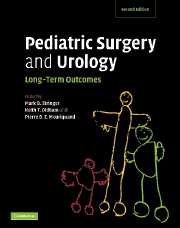Book contents
- Frontmatter
- Contents
- List of contributors
- Acknowledgments
- Preface
- Part I General issues
- Part II Head and neck
- Part III Thorax
- Part IV Abdomen
- 20 Abdominal surgery: general aspects
- 21 Abdominal wall defects
- 22 Inguinal and umbilical hernias
- 23 Infantile hypertrophic pyloric stenosis
- 24 Small bowel disorders
- 25 Cystic fibrosis
- 26 Necrotizing enterocolitis
- 27 Inflammatory bowel disease in children
- 28 Intestinal failure
- 29 Appendicitis
- 30 Hirschsprung's disease
- 31 Anorectal malformations: experience with the posterior sagittal approach
- 32 Gastrointestinal motility disorders
- 33 The Malone antegrade continence enema (MACE) procedure
- 34 Splenectomy
- 35 Biliary atresia
- 36 Choledochal cyst
- 37 Biliary stone disease
- 38 Portal hypertension
- 39 Persistent hyperinsulinemic hypoglycemia in infancy
- 40 Acute and chronic pancreatitis in children
- Part V Urology
- Part VI Oncology
- Part VII Transplantation
- Part VIII Trauma
- Part IX Miscellaneous
- Index
- Plate section
- References
29 - Appendicitis
from Part IV - Abdomen
Published online by Cambridge University Press: 08 January 2010
- Frontmatter
- Contents
- List of contributors
- Acknowledgments
- Preface
- Part I General issues
- Part II Head and neck
- Part III Thorax
- Part IV Abdomen
- 20 Abdominal surgery: general aspects
- 21 Abdominal wall defects
- 22 Inguinal and umbilical hernias
- 23 Infantile hypertrophic pyloric stenosis
- 24 Small bowel disorders
- 25 Cystic fibrosis
- 26 Necrotizing enterocolitis
- 27 Inflammatory bowel disease in children
- 28 Intestinal failure
- 29 Appendicitis
- 30 Hirschsprung's disease
- 31 Anorectal malformations: experience with the posterior sagittal approach
- 32 Gastrointestinal motility disorders
- 33 The Malone antegrade continence enema (MACE) procedure
- 34 Splenectomy
- 35 Biliary atresia
- 36 Choledochal cyst
- 37 Biliary stone disease
- 38 Portal hypertension
- 39 Persistent hyperinsulinemic hypoglycemia in infancy
- 40 Acute and chronic pancreatitis in children
- Part V Urology
- Part VI Oncology
- Part VII Transplantation
- Part VIII Trauma
- Part IX Miscellaneous
- Index
- Plate section
- References
Summary
Acute appendicitis is the most common surgical emergency in childhood. Appendicitis may present at any age, although it is uncommon in preschool children. Approximately one-third of children with acute appendicitis have perforation by the time of operation. Despite improved fluid resuscitation and better antibiotics, appendicitis in children, especially in preschool children, is still associated with significant morbidity.
Historical aspects
Early reports of appendicitis were usually based on autopsy findings. In 1736, Amyand reported an operation on a boy with a perforated appendix in a scrotal hernia. Several important contributions toward the diagnosis and treatment of appendicitis were made during the 1880s. The term appendicitis was first used in 1886 by the Harvard pathologist Reginald Fitz, who provided an extraordinary description of the signs and symptoms of both acute and perforated appendicitis and, in addition, appreciated the role of luminal obstruction in the pathogenesis of appendicitis. He stressed the importance of early diagnosis and treatment by laparotomy. Although drainage of an appendiceal abscess had been performed earlier, Mortin, in 1887, did the first successful appendectomy for perforated appendicitis. In 1889, McBurney published his classical description of the typical tenderness in the right lower quadrant and recommended early operation. Although modern antibiotics and intravenous administration of fluids have improved the outcome for children with appendicitis, the basic principles of early diagnosis and appendectomy remain the same as described by McBurney over 100 years ago.
- Type
- Chapter
- Information
- Pediatric Surgery and UrologyLong-Term Outcomes, pp. 374 - 384Publisher: Cambridge University PressPrint publication year: 2006
References
- 2
- Cited by

